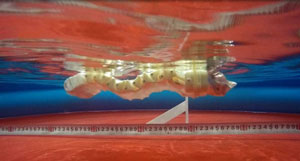One day, a small, snakelike robot might make the same journey through your intestines.
Researchers at Ben-Gurion University of the Negev in Be’er Sheva, Israel, have created a robot that may one day replace expensive colonoscopies and inefficient pill cameras. The device is about the size of an AA battery (2.6cm wide and 5cm long). Its developers believe it is the first robot to move by sine wave motion using only a single motor. They dubbed it SAW for its single actuator wave mode of transport.
“In the near future, I want to see a robot crawling deep inside a human intestine doing procedures,” said Nir Dgani, a mechanical engineering student working on the bot.

That starts with taking pictures. Today, if you want to film the small intestine the only options available are camera pills or colonoscopies. A camera pill is the simplest route, though it requires up to 12 hours to pass through the intestine. Camera pills also have limitations. They cannot stop to take more photos of problem areas. Instead, as the intestines push them along, they may get stuck in some places or move too quickly in others. And since camera pills are passive, they cannot perform biopsies or cauterizations or release medicine where needed.
A colonoscopy offers more flexibility, but procedures are expensive and usually require the patient to go under anesthesia and take the day off from work.
Though it’s still in prototype form, SAW aims to solve these issues with its combination of controlled motion, compact size, and ability to carry diverse payloads, said David Zarrouk, a roboticist at the university and head of the project.
Helical Motion
Zarrouk has been working on this project for the past 10 years, but came up with the idea for a wave-propelled robot just two years ago while teaching a class in mechanical design. “I was looking at a mechanical spring and, for a second, I thought, ‘What happens if you rotate the mechanical spring?’” he recalled.
Zarrouk modeled his idea and discovered that designing a helix-like spring with a very large pitch creates a sine wave that moves the robot forward like a snake, eel, or crocodile.
Zarrouk and his team attached dozens of links onto the helix, binding them to each other with a circular joint. He added a small brushed motor that was easy to control and required only a small battery for energy. When the helix rotated, it creates an advancing wave that propelled the robot forward.
Using a wave-like motion improves the ability of the device to work in the unstable small intestines, with its high compliance and very slippery walls.
“For very small devices, a millimeter and below, it’s like swimming in honey—you won’t go forward,” Moshe Shaham, a roboticist at the Technion Institute of Technology in Israel and an ASME fellow, said. “You have to swim by waving the tail.”
Building SAWs
Wave locomotion enables SAW to travel the entire 8-meter length of the intestine in about two hours—and it would still have enough battery life to move back and forth with the intestine for another 100m or more or keep the camera running for ten hours. While it drains the battery to do both at the same time, even the prototype should have no problem lasting for the few hours needed to complete the procedure, Shaham said. Then, when done, the robot will be small enough to exit the body naturally.
This is much more convenient than undergoing anesthesia for a colonoscopy or waiting 12 hours for a pill camera to pass. Plus, SAW’s simplicity of design keeps costs down. The researchers 3D print SAW robots using photopolymer, which should be able to survive in the body without degrading, though researchers said they may switch materials to be FDA compliant. It also has very few moving parts. “The simplicity is what makes this robot,” Zarrouk said. “If the robot was complex or made of too many parts, this would make it more expensive.”
The next challenge is to shrink the robot and start testing it in dead animals.
“We hope by the end of the year we’ll be able to have it small enough to make experiments inside the intestines of a pig,” Zarrouk said.


Comments are closed, but trackbacks and pingbacks are open.